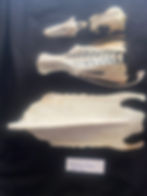Bird bits on the beach
- Susan Elaine Jones
- Aug 2, 2023
- 3 min read
Updated: Aug 3, 2023
April seemed to have been a good month for finding bird skeletons on Orkney beaches. I started the week with a casual "oh, that'll be a pelvis, but I wonder which bird?" to ending the week with my trusty companions hunting on every beach for everything - it seems beach combing is infectious. My least-bone-most-squeamish-acquaintance on a common photo trip in week two, who had started the week with thinking me "a bit grim", by the end of the week was picking up rotting seagulls to wave "do you want this?" at me! "For god's sake, put that diseased rotting thing down!" Unfortunately not only beackcombing, but also avian flu is infectious. But we all came back healthy, and I had a big enough haul of bones to fill a few boxes, and offer spares as reference sets to the local Wildife Trust, and more extras for Lisa Temple-Cox.



But, having struggled to identify not only whose pelvis is whose, but also skulls and keels, I thought I should put together my quick list of good help.
Bird skulls - skullsite.com - this is the best site is for identifying bird skulls. It has many specimens as 3D models, which can really help when trying to compare at odd angles.
Another helpful thing to note is that, because bird's upper beaks can move independently of the skull at the hinge, they often break off, leaving a confusing skull fragment like the ones at the bottom of this picture.
Bird pelvises. They are confusing as heck, as they're so different from mammals. A random chap called John Rocester has a really good flickr site of reference photos for all sorts of bones, and really good comparison photos, such as this one. Good not just for pelvises, not just for birds, but all sorts of bones you might find! I especially love this as it shows those "flanges" at the top of the pelvis relate to birds that stand and walk a lot - especially the cormorant and shag. Whereas a small, long and sleek pelvis indicates a bird that swims and dives a lot like the gannet. Also note the size differences - the grey heron pelvis is remarkably small compared to the others despite it being quite a big bird.
Finally, and I love that this exists, JakesBones is a former blog site of a very keen kid who colelcted and analysed bones. A fantastic resource. You can just get absorbed in his posts and the enthusiasm that bubbles over. Here's a post just on a random skull a friend sent him.
The combination of those three sites gives a good start for identifying any bird bones. The only problem after that is having a first clue, eg that the sternum/breast bone has dints in the edges which can look like tooth holes, confusing people into thinking it is a mammal jaw. It is amazing how many mammal bones were on the shore - a lot of sheep, some cow, and the odd bit of seal. (I was stumped for AGES trying to identy one bone that turned out to be the remains of a T-bone steak. That is what I get for 40 years of vegetarianism!)
So, after a few months of mulling over the finds, and finally getting my act together to label and catalogue my bones, I can re-sort my bundles into birds. And notice the difference is size





For the really difficult bits, of course, I do have my museum bird skeleton photos collection, which may help others. https://www.susanelainejones.com/birds But it is more difficult to identify single bones from these articulated skeletons. Hopefully I'll get time to take better photos of my finds and add an addition section for isolated bones.
But until then, enjoy your beachcombing. Always travel with a bones bag. And leave the gross dead birds alone - avian flu is infectious for weeks after death.


